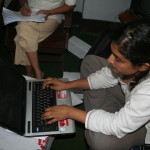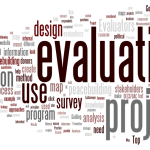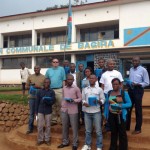DM&E for Peacebuilding Blog: Evaluating Capacity Development Initiatives
The following blog was written by Jonathan White for SFCG’s Learning Portal for Design, Monitoring, & Evaluation for Peacebuilding. You can find the original post here.
Capacity development seems to be all the rage these days. Many donors require capacity development to be built into any project they fund; this includes USAID’s own Conflict Management and Mitigation office. The popularity of capacity development is further evidenced by the shifting semantics surrounding the terminology itself: we’ve moved from ‘capacity building’ to ‘capacity development’ in order to avoid the implication that no capacity existed to begin with (i.e., ‘building’).
But how do we go about assessing and evaluating capacity? And, furthermore, what does this imply for the processes by which we design capacity development initiatives?
Let’s explore, but first here are a few key definitions courtesy of the OECD-DAC:
- Capacity is the ability of people, organizations and society as a whole to manage their affairs successfully.
- Capacity development is the process by which people, organizations, and society as a whole unleash, strengthen, create, adapt and maintain capacity over time.
Hot Tip! Keep in mind, some organizations define capacity differently, and this may have consequences for your development strategy!
Show me the Evidence
Clearly, you won’t know if capacity has been developed unless you take a baseline measurement. Personal anecdotes, like “I believe I am more equipped to design projects after the training,” just don’t cut it anymore.
Just as personal anecdotes don’t cut it anymore, neither do gut, intuitive decisions on which local capacities will be developed. Where’s your intentional strategy? How is that strategy based in evidence for the development of specific capacities? And how will those capacities build on or compliment other project activities (or, if you are really practicing systemic peacebuilding, programmatic activities and its connections) in order to help you achieve your goal and objectives?
Being explicit about our strategies matters; impact is generally the result of interaction between intentional and unintentional strategies, and it is important to be as explicit as possible in order to better understand which assumptions and strategies worked best, or not at all.
These might sound like difficult questions requiring a complex methodology, but chances are you’re already familiar with many of the tools and methods; it may be as simple as incorporating a few extra steps in your initial conflict and context analyses—an extra round of interviews and surveys with a slightly shifted focus to examine capacity on certain issues and their interactions with the context and conflict. Check out the following resources the next time you are preparing to design a capacity development component of a project.
Hot Resource! Check out UNDP’s Capacity Assessment Methodology User’s Guide
Yah Got to Learn to Walk before You Run
Capacity is not something that resides solely within individuals: it is also in the collective; the societal level. It is generally accepted that there are three analytical levels regarding capacity development:
[1]
- Individual
- Organizational
- Enabling environment
In addition, a fourth level is implied: the systemic level, i.e., the sum of interactions between the three primary analytical levels.
Hot Resource! Check out the Evaluation Capacity Development Group’s Guide to Evaluation Capacity Development for tips of thinking systemically for capacity development.
Which level, then, is your project trying to affect? Your conflict and context analyses should suggest potential routes forward: for example, is the project (i.e., the capacity development project) taking place in an environment that supports or mitigates capacity development? Is the ‘issue’ a lack of capacity (at individual or organizational levels) or the presence of strong contextual forces that prevent capacity from being fully exercised, such as corruption or political disenfranchisement? And how will working at one level affect other levels of capacity?
Hot Resource! Check out OECD-DAC’s The Challenge of Capacity Development: Working Towards Good Practice page 17 for examples of an enabling environment for capacity development for each of the analytical levels.
Distinguishing between these levels is more than just semantic. Working to develop individual capacity suggests different strategies (theories of change) than working to develop an enabling environment for capacity development. And more than just strategy, the decision to focus on a particular level will also affect what outcomes and impacts that project is able to realistically achieve. A thorough analysis of capacity as part of the context analysis is therefore essential. And remember, a context analysis is different from a conflict analysis!
Back to Basics: The Importance of Context Analysis
“Analysis is not optional; it is essential and obligatory for peace work.” –Reflecting on Peace Practice project participant
[2]
The ‘Listening Project’ by CDA Inc. has consistently found that one of the most important and fundamental step in international assistance is a thorough context analysis. And yet practitioners often only do a partial analysis and, furthermore, many do not differentiate between a context analysis and a conflict analysis. The difference matters.
Hot Resource! Check out CDA Inc.’s Reflecting on Peace Practice Participant Training Manual for more on conflict and context analysis differences and best practices.
If we are serious about developing local capacities as a viable strategy for international assistance, we must more seriously analyze existing capacities and the environment in which they reside (individual, organization, enabling environment and their systemic interactions). Impact begins with design, and design must begin with analysis.
Hot Resources
Hot Resource! Capacity.org: A Gateway for Capacity Development (Espanol; Francais)
Free Online! Capacity Assessment Methodology User’s Guide by UNDP
Free Online! Monitoring and Evaluation Short Cuts: Capacity Building Guidance edited by Guy Sharrock for Catholic Relief Services
Free Online! Capacity Building Guidance: Guidelines and Tools for Getting the Most from Your Technical Assistance by Rosalie H. Norem and Constance McCorkle for Catholic Relief Services
Free Online! A Menu of Assessment Activities by Brett A. Magill
Free Online! The Design and Use of Capacity Development Indicators by Peter Morgan for CIDA
Jonathan White is the Content Manager for SFCG’s Learning Portal for Design, Monitoring, & Evaluation for Peacebuilding. The Learning Portal is community of practice for DM&E peacebuilding professionals that provides a transparent and collaborative space for the sharing of knowledge to improve the practice of DM&E for peacebuilding and increase the effectiveness of peacebuilding programs. The Learning Portal website can be found at www.dmeforpeace.org and you can follow them on Twitter @DMEforPeace.










Thank you Jonathan for this write up. It opens up door for further learning.